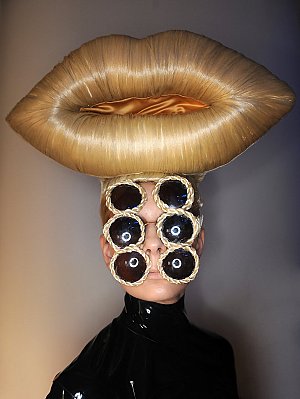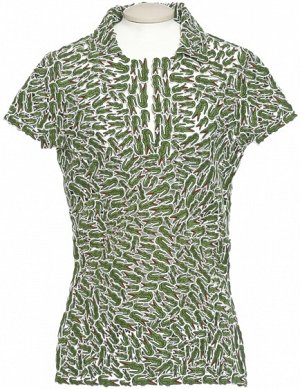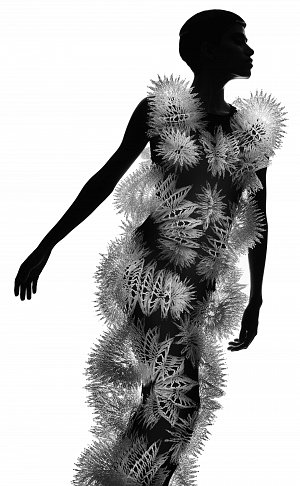« Cheveux et poils »
Musée des Arts Décoratifs, 2023

Coiffure de Charlie Le Mindu, « Blonde lips », collection printemps-été 2010 dite « Girls of paradise »
© DR
This exhibition focuses on the area between fashion and the representation of the body to show how hairstyles and the arrangement of human hair have participated for centuries in the construction of appearances. “ Cheveux et poils “ is a new chapter in a sequence of exhibitions that includes “La Mécanique des dessous, une histoire indiscrète de la silhouette“ (2013), “Tenue correcte exigée, quand le vêtement fait scandale“ (2016), and “Marche et démarche, une histoire de la chaussure“ (2019).
One only needs to think of the names of a few hairstyles from the 17th to the 20th century—à la Fontange, à la Titus, à la garçonne, the Mohawk—to be reminded that hair can be a fashion phenomenon, revealing social and cultural codes decipherable by contemporaries. Because it is a bodily material, and by far the most convertible—for it can be straightened, cut, extended, colored, decorated, hidden, or exhibited—hair is an essential element in how we present ourselves. It allows us to display our adherence to a fashion, to show our conviction or contestation, and carries a multitude of senses: femininity, virility, negligence etc.
As the exhibition shows, disheveled or excessive hair have often been associated in Western culture with the wild man and the animal, to the point that for centuries civilized men and women had to comb, tame, and sometimes even hide their mane. On the contrary, for a number of anti-establishment movements, hairstyle is a way to boldly reject the social order.
Ranging from the end of the Middle Ages to our era, the exhibition will deal with several themes inherent to the history of hairstyles (combed, cut, or covered hair; wigs, hairpieces, baldness; coloring etc.), without forgetting the question of facial hair (clean-shaven faces, beards, mustaches, eyebrows etc.) and body hair (chest, legs, pubis, armpits, hair removal or its pointed rejection).
From the hairdresser Monsieur Antoine to the designs of Martin Margiela, the frequent use of sophisticated hairstyles and hair extensions in 20th and 21st-century fashion will also be considered.

« Mode et sport »
Musée des Arts Décoratifs, 2023

Estudio Campana (Humberto Campana,1953, Rio Claro, Brésil, et Fernando Campana, 1961, Brotas, Brésil), pour Lacoste
Broderie machine, piqué de coton. Don Devanlay-Lacoste S.A
© Les Arts Décoratifs / photo : Jean Tholance
In celebration of the occasion of the 2024 Summer Olympic Games, to be held in Paris from July 26th through August 11th, the Musée des Arts Décoratifs will showcase an exhibition that investigates the links between two very different, often unrelatable worlds - Fashion and Sport - focusing on perhaps an overlooked similarity that these two domains share: the ideal human body. Dating as far back as Greek antiquity, the ideal human body, typically depicted in the nude, has been the central aspect of an athlete’s equipment. As more intricate sports were invented, so too were specialized costumes.
A competitor’s outfit, be it a fencing costume or a baseball uniform, serves to both protect the athlete while enhancing their skills. An athlete’s outfit may also indicate their level (Judo belts), their victories (the yellow jersey of the Tour de France), or the team to which they belong. Spectators, once clad in the simple togas of ancient Greece, are also part of this development as their clothing may bear the insignia of their favorite team, depict an image of their favorite player, or depict their membership of a sports enthusiast association.
Innovations also emerged in shapes, cuts, textiles, and materials, facilitating an athlete’s movement, thus, enhancing their performance.
In the 20th century alone, these transformations range from the legendary tennis player, Rene Lacoste, tearing his shirtsleeves off to allow for an improved range of motion when striking the ball, to the technical fabrics designed through cutting-edge research in laboratories.
These improvements in sporting garments have also made their mark on every-day fashion, where, over the centuries, the main purpose of clothing design has begun to focus evermore on one simple objective: comfort. This objective has been particularly crucial in the lives of women, who, over the last several decades, have relied on the design of sportswear as a means of altering what was and is considered acceptable in women’s daily fashion, such as the use of skirts, shorts and pants.
In Contemporary Fashion, Sportswear is ubiquitous : the logos and insignia of the largest sportswear design houses are instantaneously recognized across the globe. Sneakers, once footwear used exclusively for practicing sport, are now designed for daily wear. Famous athletes and teams have become the ambassadors of luxury fashion houses through sponsorships and modern advertising practices.

« Iris van Herpen »
Musée des Arts Décoratifs, 2023

Iris van Herpen
Photographie
© Iris Van Herpen, Amsterdam
The Iris van Herpen Maison was founded in 2007 and showcases its collections bi-annually at Paris Haute Couture Week as a member of the Fédération de la Haute Couture. The brand stands for slow fashion with a multi-disciplinary approach towards collaborations with artists, architects and scientists.
Iris van Herpen perceives Haute Couture as a transformative language, an interdisciplinary entity that emerges from the space in which innovation and craftsmanship interlace. Trained in classical ballet, Iris van Herpen contemplates movement as a metamorphic force which in a duet with fashion, can extend the forms of the human body. Each collection is a quest to venture beyond today’s definition of a garment, exploring new forms of femininity for a more meaningful, diverse and conscious fashion for the future.
Stitching the intricacies of craftsmanship with the pioneering spirit of innovation, Iris van Herpen blurs the lines between art and design. Celebrating an inclusive approach where collaboration creates community, the Maison integrates sustainability as second nature. The immaculate creations extend their reach at exhibitions in world-leading museums including the Metropolitan Museum of Art in New York, Victoria & Albert Museum in London and Palais de Tokyo in Paris.
The scope for imagination is perpetual through the eyes of Iris van Herpen.
